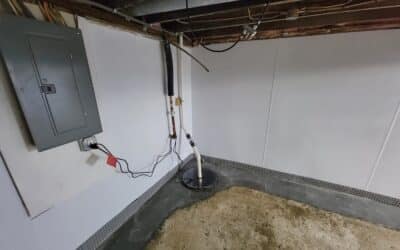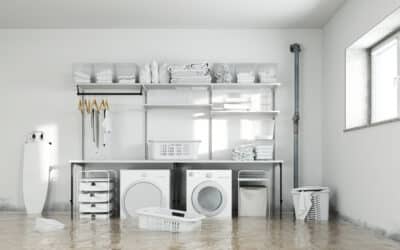You walk down the stairs and catch that familiar musty smell. It’s just a little dampness—harmless, right? Think again. From mold spores to hidden allergens, damp basements are silent culprits behind many unexpected health issues. Keep reading to learn about the signs of moisture, how it’s getting in, the effects it has on your home and your health, and what you can do about it.
Signs of Moisture in Your Basement
Musty odors and damp air can signal water issues in your home. Common signs of moisture also include:
- Water stains: Dark or discolored patches on the walls or floors
- Efflorescence: White, powdery mineral deposits on concrete or masonry
- Visible presence of mold and mildew: Black, green or white growths with a strong, earthy odor
- Rusty or water-damaged materials: Evidence of rot, mold, or moisture damage
If you’re noticing any of these signs, it’s important to act quickly to identify the source of the moisture
Moisture Sources
The most common ways water infiltrates a home include poor drainage, foundation issues, or weather-related factors. Rainwater or melting snow that collects around a home’s foundation can seep through cracks in the basement walls or floor, especially if the soil is saturated or the grading slopes toward the house. Faulty or clogged gutters and downspouts can cause water to overflow and pool near the foundation.
Moisture can also linger in a home due to everyday indoor activities that generate humidity, such as cooking, showering, or doing laundry. Without proper ventilation, this moisture accumulates in the air and settles on cool surfaces like windows, walls, and pipes and leads to condensation. Improperly vented appliances or excessive use of humidifiers can also contribute to high moisture levels.
Health Concerns
When trapped moisture is not properly managed, it can lead to several health concerns. The most common concern is mold and mildew growth, which impacts your home’s air quality. When the air is humid, it provides the perfect conditions for mold spores to settle and grow. Health concerns related to mold exposure include:
- Asthma, allergies, or chronic coughing
- Irritated eyes, nose, throat, and skin
- Lung infections in those with weakened immune systems
Safety and Structural Concerns

Moisture can also signal a bigger issue with the foundation or structure of your home. Look for these structural concerns and contact a professional immediately:
- Cracks: Long-term water pressure, known as hydrostatic pressure, can lead to cracking in your basement walls. Horizontal cracks are of specific concern as they may compromise the stability of the foundation over time.
- Bowing or bulging walls: Severe wall bowing caused by hydrostatic pressure could lead to collapse if not corrected.
- Concrete spalling, wood rot, or rusting metal supports: Moisture buildup on these materials can reduce their load-bearing capacity.
Your health and safety are too important to ignore moisture concerns.
Exterior Solutions
Homeowners may be able to prevent water from entering their home by making minor improvements to their home and property.
- Improve grading and drainage: Soil should slope away from the foundation.
- Clean and extend downspouts: Water should be directed at least 4-6 feet away from the foundation.
- Install or repair gutters: Did you know your gutters may not be sized correctly for your roof? Ensure gutters do not leak and that they are properly sized for your home.
- Seal cracks in foundation walls: Epoxy or polyurethane injections are a quick fix for small cracks. Larger structural cracks should be inspected by a basement professional.
Interior Solutions
The following solutions allow homeowners to control or remove moisture from their homes.
- Use a dehumidifier: Managing humidity levels in your home helps protect the air quality.
- Seal basement walls and floors: Waterproof paints can help reduce dampness in your home.
- Ensure proper ventilation: Appliances, like dryers, should be vented to the outside. Finished basements may require ventilation systems.
Basement Waterproofing

Some moisture concerns are too significant for a quick solution and may require the help of a basement professional. Depending on the source of water infiltration, exterior or interior waterproofing may be the best solution for your home.
Exterior waterproofing applies a waterproof membrane around your home’s foundation to prevent water from coming in. French drains are another option to direct water away from the foundation.
Interior waterproofing helps when water comes up through cracks in the basement floor. Installing an interior drainage system with a sump pump is an effective strategy for keeping basements dry.
Basement waterproofing maintains the structural integrity of your home, prevents mold and mildew, and stops water infiltration. Larger structural concerns like cracks or bowing walls require professional solutions and need to be addressed even if the water infiltration has stopped.
Invest in your Health and Home
Finding the right solution to your damp basement can seem overwhelming. When your health and your home’s safety hang in the balance, it’s important to get the right help. Our team at Pioneer Basement Solutions offers free inspections to help homeowners make decisions to protect their health and maintain the safety of their home. Contact us today to schedule your free inspection.


